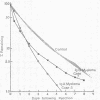Abstract
The in vivo metabolism of radioiodinelabeled C1q was determined in patients with hypogammaglobulinemia, multiple myeloma, systemic lupus erythematosus (SLE), and in healthy controls. Marked differences in metabolic behavior were observed with a much more rapid disappearance of plasma radioactivity in patients as compared with controls. Estimated plasma volumes at 10 min after injection (time 0) were normal in controls and the SLE patient, mean 40 ml/kg, whereas they were grossly elevated, 57-82 ml/kg, in the hypogammaglobulinemic and myeloma patients, indicating significant loss of C1q-125I during the initial mixing period. Absence of a distinct initial equilibration phase of radioactivity loss from the plasma suggested significant reversible interaction of the labeled C1q with plasma proteins and density gradient studies provided evidence for in vivo uptake into the circulating trimolecular first component complex (C1q, r, s). In controls and the SLE patient 0.51-0.75 of the C1q was retained in the plasma space while only 0.28 or less was in the others. The daily plasma pool fractional C1q catabolism was 0.65-0.67 in controls compared with 0.95-4.80 in the patients. C1q synthetic rates in controls were 4.64 and 4.34 mg/kg per day while higher rates, 4.94-37.40 occurred in the patients.
These experiments clearly indicate that the metabolism of C1q is markedly influenced by serum IgG concentrations, probably related to the reversible interactions of C1q with IgG, and also affected by interactions with C1r and C1s. The decreased serum C1q often present in hypogammaglobulinemia and myeloma relates to an increased catabolism and higher extravascular distribution rather than impaired C1q synthesis. In contrast, a second distinctly different basis for decreased C1q occurs in SLE; increased utilization by an ongoing immunopathogenic process.
Full text
PDF







Images in this article
Selected References
These references are in PubMed. This may not be the complete list of references from this article.
- BERSON S. A., YALOW R. S., SCHREIBER S. S., POST J. Tracer experiments with I131 labeled human serum albumin: distribution and degradation studies. J Clin Invest. 1953 Aug;32(8):746–768. doi: 10.1172/JCI102789. [DOI] [PMC free article] [PubMed] [Google Scholar]
- CHRISTIAN C. L., HATFIELD W. B., CHASE P. H. Systemic lupus erythematosus. Cryoprecipitation of sera. J Clin Invest. 1963 Jun;42:823–829. doi: 10.1172/JCI104774. [DOI] [PMC free article] [PubMed] [Google Scholar]
- Claman H. N., Merrill D. Hypergammaglobulinemia--the role of the immunoglobulins (gamma G, gamma A, gamma M). J Allergy. 1965 Sep-Oct;36(5):463–471. doi: 10.1016/0021-8707(65)90140-1. [DOI] [PubMed] [Google Scholar]
- Gewurz H., Pickering R. J., Christian C. L., Snyderman R., Mergenhagen S. E., Good R. A. Decreased C'-1q protein concentration and agglutinating activity in agammaglobulinaemia syndromes: an inborn error reflected in the complement system. Clin Exp Immunol. 1968 Jun;3(5):437–445. [PMC free article] [PubMed] [Google Scholar]
- Hanauer L. B., Christian C. L. Clinical studies of hemolytic complement and the 11S component. Am J Med. 1967 Jun;42(6):882–890. doi: 10.1016/0002-9343(67)90069-1. [DOI] [PubMed] [Google Scholar]
- Hanauer L. B., Christian C. L. Studies of cryoproteins in systemic lupus erythematosus. J Clin Invest. 1967 Mar;46(3):400–408. doi: 10.1172/JCI105541. [DOI] [PMC free article] [PubMed] [Google Scholar]
- KEENE W. R., SILBERMAN H. R., LANDY M. Observations on the pyrogenic response and its application to the bioassay of endotoxin. J Clin Invest. 1961 Feb;40:295–301. doi: 10.1172/JCI104256. [DOI] [PMC free article] [PubMed] [Google Scholar]
- Kohler P. F., Müller-Eberhard H. J. Complement-immunoglobulin relation: deficiency of C'1q associated with impaired immunoglobulin G synthesis. Science. 1969 Jan 31;163(3866):474–475. doi: 10.1126/science.163.3866.474. [DOI] [PubMed] [Google Scholar]
- Kohler P. F., Müller-Eberhard H. J. Immunochemical quantitation of the third, fourth and fifth components of human complement: concentrations in the serum of healthy adults. J Immunol. 1967 Dec;99(6):1211–1216. [PubMed] [Google Scholar]
- Kohler P. F., Ten Bensel R. Serial complement component alterations in acute glomerulonephritis and systemic lupus erythematosus. Clin Exp Immunol. 1969 Feb;4(2):191–202. [PMC free article] [PubMed] [Google Scholar]
- MORSE J. H., CHRISTIAN C. L. IMMUNOLOGICAL STUDIES OF THE 11S PROTEIN COMPONENT OF THE HUMAN COMPLEMENT SYSTEM. J Exp Med. 1964 Feb 1;119:195–209. doi: 10.1084/jem.119.2.195. [DOI] [PMC free article] [PubMed] [Google Scholar]
- MORSE J. H., MULLER-EBERHARD H. J., KUNKEL H. G. Anti-nuclear factors and serum complement in systemic lupus erythematosus. Bull N Y Acad Med. 1962 Oct;38:641–651. [PMC free article] [PubMed] [Google Scholar]
- MULLER-EBERHARD H. J., KUNKEL H. G. Isolation of a thermolabile serum protein which precipitates gamma-globulin aggregates and participates in immune hemolysis. Proc Soc Exp Biol Med. 1961 Feb;106:291–295. doi: 10.3181/00379727-106-26313. [DOI] [PubMed] [Google Scholar]
- McConahey P. J., Dixon F. J. A method of trace iodination of proteins for immunologic studies. Int Arch Allergy Appl Immunol. 1966;29(2):185–189. doi: 10.1159/000229699. [DOI] [PubMed] [Google Scholar]
- Müller-Eberhard H. J. Complement. Annu Rev Biochem. 1969;38:389–414. doi: 10.1146/annurev.bi.38.070169.002133. [DOI] [PubMed] [Google Scholar]
- O'Connell E. J., Enriquez P., Linman J. W., Gleich G. J., McDuffie F. C. Absence of activity of first component of complement in man: association with thymic alymphoplasia and defective inflammatory response. J Lab Clin Med. 1967 Nov;70(5):715–724. [PubMed] [Google Scholar]
- PEARSON J. D., VEALL N., VETTER H. A practical method for plasma albumin turnover studies. Strahlentherapie. 1958;107(SONDERBD):290–297. [PubMed] [Google Scholar]
- Stroud R. M., Nagaki K., Pickering R. J., Gewurz H., Good R. A., Cooper M. D. Sub-units of the first complement component in immunologic deficiency syndromes: independence of Cls and Clq. Clin Exp Immunol. 1970 Aug;7(2):133–137. [PMC free article] [PubMed] [Google Scholar]
- TARANTA A., WEISS H. S., FRANKLIN E. C. Precipitating factor for aggregated gamma-globulins in normal human sera. Nature. 1961 Jan 21;189:239–240. doi: 10.1038/189239a0. [DOI] [PubMed] [Google Scholar]
- Waldmann T. A. Disorders of immunoglobulin metabolism. N Engl J Med. 1969 Nov 20;281(21):1170–1177. doi: 10.1056/NEJM196911202812107. [DOI] [PubMed] [Google Scholar]
- Wochner R. D., Drews G., Strober W., Waldmann T. A. Accelerated breakdown of immunoglobulin G (IgG) in myotonic dystrophy: a hereditary error of immunoglobulin catabolism. J Clin Invest. 1966 Mar;45(3):321–329. doi: 10.1172/JCI105346. [DOI] [PMC free article] [PubMed] [Google Scholar]




